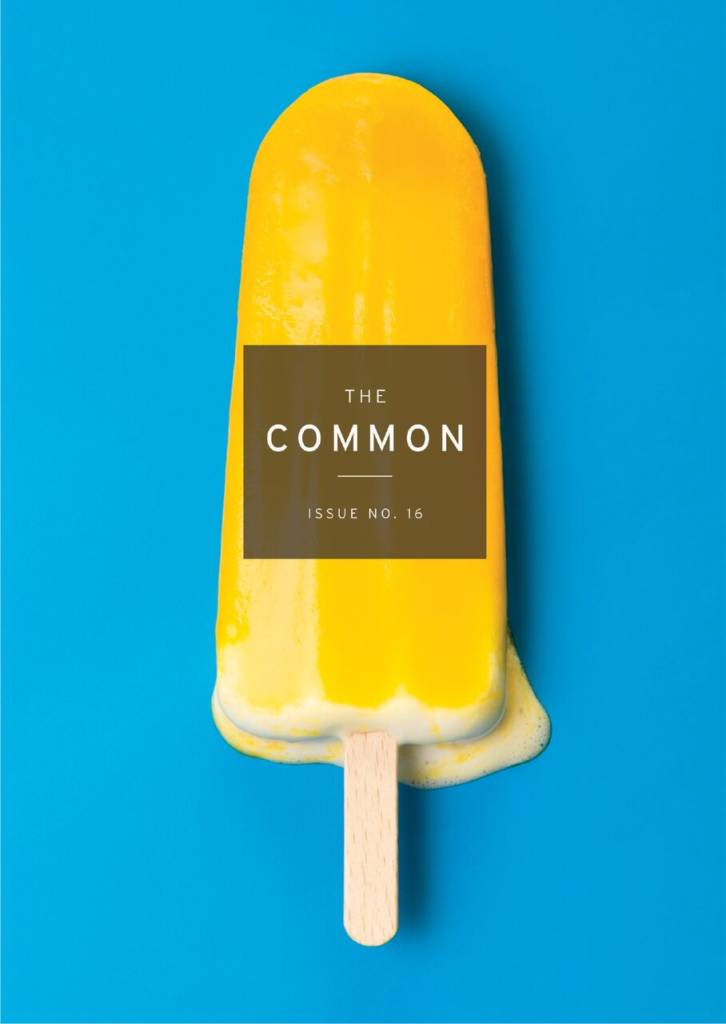By RALPH BURNS
We had to leave because someone saw my
father set his bottle down. Because
of something in us we leaned into one another
By RALPH BURNS
We had to leave because someone saw my
father set his bottle down. Because
of something in us we leaned into one another

We hope you’ll join us virtually for the seventh annual LitFest, hosted in conjunction with Amherst College. This year’s lineup includes Pulitzer Prize winners Natalie Diaz and Viet Thanh Nguyen; 2021 National Book Award nominees Katie Kitamura and Elizabeth McCracken; and journalists Vann Newkirk and David Graham, among others.
This year, we are continuing to highlight the work of The Common’s own Literary Publishing Interns and Amherst Alumni Authors during a virtual reading at 4pm on Saturday, February 26. The Common is also hosting, in collaboration with Restless Books, a conversation with winners of the Restless Books Immigrant Writing Prize, Deepak Unnikrishnan, Grace Talusan, and Ani Gjika. Join us for this packed weekend!
Enrich your classroom with The Common magazine: poems, essays, stories, and images that provide fresh, global perspectives on place and placelessness, home and belonging, migration and exile.
Thanks for submitting your email; we’ll be in touch soon with additional resources.
Adapted from Curtis Bauer, The Common’s Translation Editor, and Director of Creative Writing Program and teacher of Comparative Literature at Texas Tech University.
In this exercise you will explore the multidimensionality of a poem, essay, or story by “living with” the author and translator: reading and thinking about their work every day for a week. This is a multi-step assignment so read carefully and make sure you plan in advance.
Enrich your classroom with The Common magazine: poems, essays, stories, and images that provide fresh, global perspectives on place and placelessness, home and belonging, migration and exile.
Thanks for submitting your email; we’ll be in touch soon with additional resources.
Divide students into small groups (trios work well) and give them a week to:
Example
One group chose Fatimah Asghar’s poem “Kul” from Issue 14, read the poem aloud, and noted that it was based on one word that could mean several, potentially opposite things – a contronym. The students had generated a list of contronyms in advance and projected them on the board (e.g., “sanction,” “oversight,” and “left”). They then invited their classmates to write at least a few lines of a poem that would, in their words, embrace these opposite meanings.
“I like this exercise not only because it gets students engaging with the fresh texts in detailed ways (at the same time we are all receiving and getting into our new issues) and working together, but also because it gives them a sense of what it is like to be in front of a class, teaching (potentially useful information for those who may be considering that path.)” – Amy Weldon
Adapted from Amy Weldon, Professor of English, Luther College
Student-led discussion:
Ask student groups or individual students to lead discussions on essays and poems from a single issue, identifying specific attributes of place-based writing and how that might apply to their own writing and/or how they perceive the places they inhabit.
Workshops:
Ask students to read all the poems, stories, or essays in a single issue, and to discuss them as a group—how they fit together and/or form a cohesive group across the whole journal, almost as if discussing a collection of poems, stories, or essays by a single author. How do they fit together with the rest of the issue?
Assignment
Identify a poem (or story or essay) from the issue that uses memory to link a past and present experience with place; write a poem (or story or essay) that functions in a similar way, but draw from your own experience.
Adapted from Curtis Bauer, Associate Professor, Texas Tech University
Learn more about teaching The Common and request a free sample issue.
Book by JINJIN XU
Reviewed by NOOR QASIM

JinJin Xu’s first chapbook, There is Still Singing in the Afterlife (Radix Media, 2020), collects twelve poems of multivarious forms, charting equally vast emotional territory–from birth to death, from one language to another, through words and subjects that are too dangerous to be said or written. This expansive collection demands a nimble, heightened attention and rewards the reader with language of great texture and depth. I first came to know Xu as an undergrad and it was a distinct pleasure to be challenged again by her work, to feel the push and pull of the poet engaging and rejecting her reader.
Poems by ANZHELINA POLONSKAYA
Translated from the Russian by ANDREW WACHTEL
Translator’s note:
Recreating the poetry of Anzhelina Polonskaya in English is tricky because her favorite poetic trope is ellipsis, which is easier to achieve in Russian. Russian, as an inflected language (like Latin), can place words in pretty much any order within a sentence, and the poet can use case endings to indicate the relationship of nouns to each other and adjectives to nouns. When something is left out of a sentence, the empty space can be filled in by the reader. Thus, a Russian poem, at least grammatically speaking, looks like a Lego construction, from which many blocks can be removed without destroying the structure. By contrast, English translations in our (almost) non-inflected language are more like houses of cards – and when you try to remove pieces of the grammatical structure the whole thing tends to fall down.
Curated by: SARAH WHELAN
Already done reading our latest Issue? Prolong the fun with these weekend reading recommendations from our Issue 18 contributors.
Recommendations: The Weil Conjectures by Karen Olsson; Marjorie Morningstar by Herman Wouk; 7th Cousins: An Automythography by Erin Brubacher and Christine Brubaker; How To Do Nothing: Resisting the Attention Economy by Jenny Odell
Testing
THE COMMON #16 FEATURES PORTFOLIO OF PUERTO RICAN WRITERS
The Fall Issue Recognizes the Vibrancy and Resilience of Puerto Rican Writers and Artists in the Aftermath of Hurricane María

Amherst, Mass.—October 15, 2018
September 2018 marked one year after Hurricane María devastated Puerto Rico, striking an island already in the thick of political and economic instability and causing an estimated 4,645 deaths. In the storm’s aftermath, many wondered: “What is the role of art in times of tragedy? What should writers and artists do with their talents?” THE COMMON’s Issue 16 features a special portfolio of Puerto Rican writers and artists that recognizes the vibrancy of literary and visual arts both on the island and in the diaspora.
Issue 16’s portfolio De Puerto Rico: Un año después de la tormenta / From Puerto Rico: One year after the storm celebrates the resilience and talents of Puerto Rican writers working in a variety of genres. In March 2018, Editor-in-Chief Jennifer Acker spent a week in San Juan interviewing and collaborating with writers, artists, and performers. “Hurricane Maria was not merely a setback or temporary disaster,” she writes in an essay published in LitHub in September. “The threat was existential. Would the island ever recover enough to support full lives and future generations?” These finely curated pieces explore this and many other questions related to the storm and its aftermath.

Issue 16 Contributor María Luisa Arroyo Cruzado
In “4,645+,” María Luisa Arroyo Cruzado asks, “What are the Puerto Rican Spanish words for aftermath? / Disaster capitalism? Intentional erasure of a modern colony?” In “Native Shore,” poet Mara Pastor drives home the unwelcome post-Maria reality: “They were counting on the debt, / but not on heavy metals in the water, / cadmium in the ash they breathe. / Nothing prepared for the poverty of the house, / for a piece of the pool collapsing…”
Mara Pastor’s poems appear in both Spanish and English, celebrating the beauty of her verse in two languages. In addition to these poems, two essays appear bilingually, and the issue features a number of works translated into English for the first time.
While the portfolio explores the harsh details of post-hurricane life in Puerto Rico, it also showcases the strength and beauty of the island. In renowned artist Adál’s photo series Los ahogados / Puerto Ricans Underwater, a woman submerged in a bathtub holds a smiling baby above the water. In another photograph, from his series Los dormidos / The Sleepers, a couple sleeps curled around a can of gasoline, the woman’s head on a pillow of ice. “Santurce, Un Libro Mural / Santurce: A Mural Book” brings to the page a collaboration by writer Francisco Font-Acevedo and artist Rafael Trelles currently installed on the streets of Santurce, the most populous and artsiest barrio of San Juan. Sergio Gutiérrez Negrón tells the story of Bimbo, a shy man who learns to love himself and the sea in “People Who Go to the Beach Alone.” National Book Critics Circle Award Finalist Willie Perdomo’s “We Used to Call It Puerto Rican Rain” is an ode to the island’s tropical weather and to its inhabitants.

Poet Willie Perdomo, Issue 16 Contributor
“I believe the creative process of this issue of The Common is in itself a reflection of the kind of conversations we should be having between the people of the United States and the people of Puerto Rico,” reflects Issue 16 contributor Ana Teresa Toro, whose essay “To Abandon Paradise” opens the portfolio. “We share the same passport but have very different experiences. To be part of this portfolio represents to me the chance not only to show our view of the world, and to tell our stories, but also to connect with readers who will expand our perspective with their own experiences.”

Issue 16 Contributor Ana Teresa Toro
Also included in Issue 16 are THE COMMON’s characteristically diverse, place-centric short stories, essays, and poems, including work by: David Lehman, series editor for The Best American Poetry and Rhode Island Poet Laureate Tina Cane; as well as up-and-coming poets like Kristina Faust, winner of the 2018 DISQUIET Literary Prize for poetry. Mindy Misener’s debut story “Baby Was Not Fine” recounts a summer job, an act of violence, and the haunting actions we can’t take back. PEN/Robert J. Dau Debut Short Story Prize-winner Ben Shattuck’s story “The History of Sound” ruminates on the connections that grow from a shared love of music. In “Land Not Theirs,” Madison Davis reflects on her experiences growing up in, and growing out of, Black churches. Lisa Chen, winner of a 2018 Rona Jaffe Foundation Writer’s Award, explores Susan Sontag’s “Project for a Trip to China” and ruminates on the death of Chen’s estranged father.
Issue 16 Launch Events
Featuring Puerto Rican writers and translators Ana Teresa Toro, Sergio Gutiérrez Negrón, María José Giménez, and María Luisa Arroyo Cruzado. Filmmaker Michelle Falcón will screen her documentary film PROMESA, which tells the stories of people affected by Puerto Rico’s economic crisis.
Free and open to the public. Dinner provided.
238 Cabot Street, Holyoke MA
Tuesday, November 6
Issue 16 Launch
Powerhouse, Amherst College
Reading and Conversation 7 pm, Reception 8:30 pm
Brief readings by and conversation with Puerto Rican writers and translators Ana Teresa Toro, Sergio Gutiérrez Negrón, María José Giménez, Willie Perdomo, and María Luisa Arroyo Cruzado, moderated by The Common Editor in Chief Jennifer Acker. Followed by a wine reception at 8:30.
Free and open to the public.
The Common is co-sponsoring the events below with the Hampshire College Art Gallery:
AgitArte is an organization of working class artists and cultural organizers that creates projects and practices of cultural solidarity with grassroots struggles against oppression, and proposes alternatives for transforming our world.
October 20-24
Four members of AgitArte—Jorge Díaz Ortiz, Dey Hernández, Sugeily Rodríguez Lebrón, and Agustín Muñoz Ríos—will give a series of campus and community presentations, including Solidaridad y sobrevivencia para nuestra liberación / Solidarity and Survival for Our Liberation, a recent cantastoria created in the aftermath of Hurricane María, and End the Debt! Decolonize! Liberate! Scroll Project, a collaboratively produced, collectively experienced art object that visually unfurls a history of colonialism and resistance in Puerto Rico.
AgitArte’s residency takes place in conjunction with the installation The Museum of the Old Colony by artist Pablo Delano, on view in the Hampshire College Art Gallery until November 11.
Saturday, October 20, 2018
Presentation (5-7 pm) followed by a community celebration
Wisteriahurst Museum, 238 Cabot Street, Holyoke, MA
Wednesday October 24, 2018
Presentation (6-7.30 pm) and reception
Hampshire College Art Gallery
About The Common
An award-winning print and digital literary journal published biannually, The Common includes short stories, essays, poems, and images that embody a strong sense of place. The Common Online publishes original content weekly, including book reviews, interviews, personal essays, short dispatches, poetry, contributor recordings, and multimedia features. Based at Amherst College, the magazine is a joint venture between the College and The Common Foundation, a 501(c)(3) nonprofit. The Common also runs the Literary Publishing Internship at Amherst College, mentoring students in all aspects of literary publishing, and regularly hosts public programming.